
|
Lockheed P-38 Lightning |
 |
||||||||
|---|---|---|---|---|---|---|---|---|---|---|
 |
 |
 |
 |
 |
 |
 |
 |
 |
 |
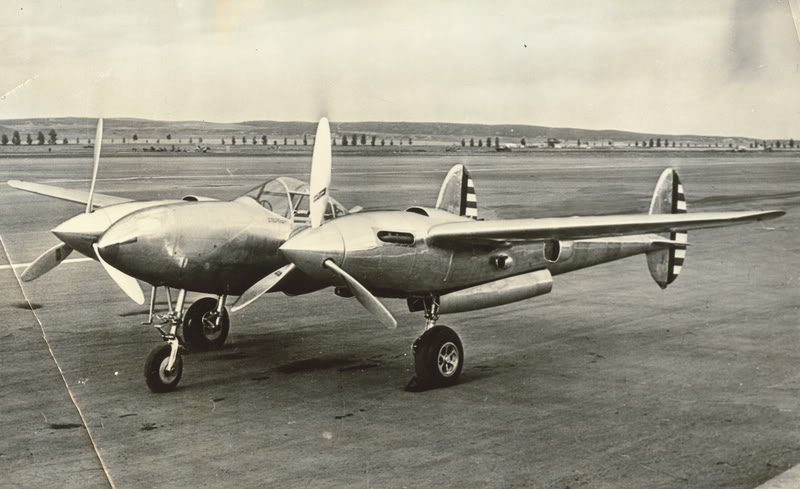 |
||||||||||||||||||||||||
|
If you can see the video controls but the video doesn't play click the link below. What would become one of the best fighters in World War II was created more by happenstance than by design. The Lockheed P-38 Lightning was originally designed as a bomber-interceptor and was never intended to be a fighter. Weight was kept to a minimum and it was far more advanced and faster than its U.S. counterparts, the Bell P-39 Airacobra and Curtiss P-40 Warhawk. It caught the attention of the US Army Air Corps (USAAC) very quickly and it would be in great demand. It was faster than the Zero—even on one engine. It shot down more Japanese airplanes than any other fighter during World War II—seven of the top scoring USAAF aces in the Pacific flew the P-38. It was as versatile as the de Havilland Mosquito, but it was the only truly successful twin-engine fighter of World War II. It was basically a hand-built airplane and was never meant to be mass produced. All skin sections were butt-joined using flush riveting, and all flight controls were metal covered. The total order was expected to be only fifty aircraft, so when orders started coming in by the hundreds, Lockheed had to scramble to find room to increase production. Over lunch, Lockheed’s president, Bob Gross, made a deal to buy the old 3-G whiskey distillery for $20,000 to make room for an additional production line. However, initial production was slow and by the time Pearl Harbor was attacked, on December 7, 1941, only 69 Lightnings were completed. When first introduced in 1939, the Lightning was able to fly a steady course at 413 mph (665 km/h) making it the fastest production airplane in the world and it remained one of the fastest climbers right up to the end of WW II. It wasn’t as fast as the Messerschmitt Me 209 which was able to attain a record 469 mph (755 km/h), but this record setting machine was built for the purposes of promoting the Messerschmitt Bf 109 and only four aircraft were built. In 1937, the USAAC sent out specification X-608 to the leading aircraft manufacturers for a new pursuit aircraft. It would be a radical departure for existing fighters and required the following specifications:
Lockheed had previously competed in 1936, but lost against Bell’s XFM-1 Airacuda. Lockheed was new in the military aircraft market and by competing against Boeing and Douglas, many felt they it was overstepping its boundaries. However, this view wasn’t shared by Lockheed’s president Robert E. Gross and he gave the go ahead for his design team to proceed with a plan. Lockheed's chief engineer, Hall Hibbard and the then young Clarence "Kelly" Johnson, and their design team would come up with one of the boldest departures from traditional American fighter development. Hibbard realized that there wasn’t an engine in the world that would meet all of the specifications for speed, range, climb, firepower and other specifications. What they needed was two engines. Hibbard looked at the new Allison V-1710 engine which had just been tested to deliver 1,000 hp (745 kW) for 150 hours. Their airplane would require two of these engines and the aircraft design was narrowed down to six selections. With the final choice decided, the Lightning was a complete break from conventional airframe design, power and armament. It had twice the power and was almost twice the size of its predecessors. It had four .50 caliber machine guns plus a 20 mm cannon—enough firepower to sink a ship—and sometimes did. By locating the guns in the central fuselage pod, this eliminated a need for propeller synchronization and the twin booms provided extra space for the engines, landing gear and turbochargers.
 A P-38F Lightning. The Lightning's tricycle landing gear and twin-boom configuration completed the list of major deviations from what might be considered conventional Army fighters. In this respect, it was very unusual that the Lightning design progressed beyond the testing stage—such radical concepts seldom achieved production status. But the simple fact was that the P-38 was needed more than ever. The Messerschmitt Bf 109 and Supermarine Spitfire had a top speed of around 350 mph (563 km/h) with a ceiling over 30,000 ft. (9,144 m) and now the Army finally had a competitor that exceeded their requirement by 40 mph (65 km/h). The XP-38 (c/n 37-457) was built under tight secrecy and made its inaugural flight on 27 January 1939, flown by test pilot Lt. Benjamin S. Kelsey. Heavy vibration was encountered on the first flight and this was due to tail flutter, which was eventually corrected in the YP-38 by installing fairings or "fillets" at the wing roots to improve airflow, installing elevator counterweights, and changing the horizontal stabilizer angle of incidence. The XP-38's initial performance justified Lockheed's investment of nearly $600,000 of its own funds to produce the prototype. Although further development was still required, the Army decided to lift the wraps of secrecy and scheduled the sole prototype for a transcontinental speed-dash on 11 February 1939 from March Field, California to Mitchell Field, New York. It was a critical decision that would haunt them for years.
 The XP-38 crashed after only 16 days. During the flight, the average airspeed was 340 mph (547 km/h) and a heavy tailwind provided a groundspeed of 420 mph (675 km/h). Two refueling stops were made at Amarillo, Texas, and Dayton, Ohio. However, on approach to Mitchell Field, Kelsey pulled back power and stalled the right engine, sending him into a steep right turn. Kelsey cut the throttle again and the plane slipped down and sheared off the tops of trees bordering the field. The undercarriage caught in a 35 foot (10 m) tree, and the plane plunged down into a sand pit on the Cold Stream Golf Course, 2,000 ft. (610 m) short of the runway. An Army investigation attributed the engine failure to carburetor ice.1 Kelsey survived and remained an important part of the Lightning program, but the airplane was a total loss. The XP-38 crashed after only 16 days with an airtime of 11 hours and 50 minutes, however despite the crash, the Army felt the aircraft showed promise and Lockheed received a contract for thirteen YP-38s along with the usual list of improvements. The flight was just 17 minutes longer than Howard Hughes’ record breaking flight in the H-1 racer, but more importantly, the crash was a major setback and delayed development of the P-38 for at least two years. Once it became operational, technical problems surfaced that could have been corrected before the aircraft was placed into service. Martin Caidin, author of “Fork-Tailed Devil: The P-38” was very critical of the USAAC decision to publicize the airplane. He asserted that the speed-dash with the sole prototype was a foolish publicity stunt which led to many casualties that could have been prevented.
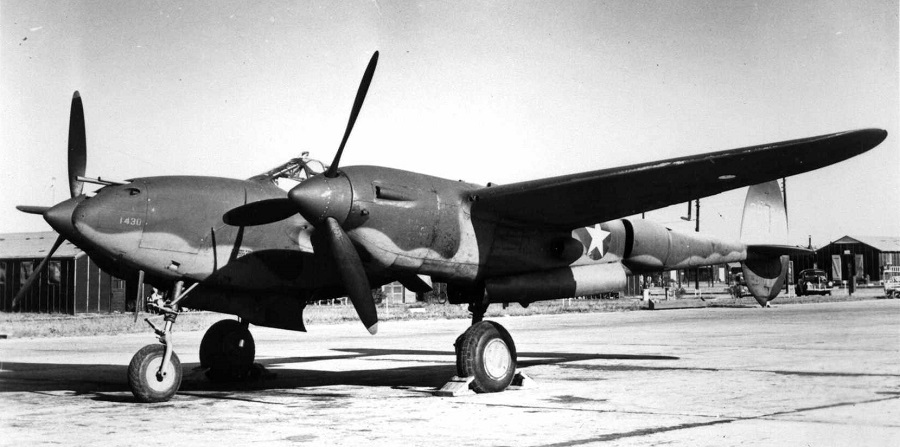 A P-38H Lightning. A major problem that surfaced was the loss of control in a dive caused by aerodynamic compressibility. During late spring 1941, USAAC Major Signa A. Gilke encountered serious trouble while diving his Lightning at high-speed from an altitude of 30,000 ft (9,120 m). When the airplane reached an indicated airspeed of about 320 mph (515 km/h), he encountered sever buffeting and the airplane's tail began to shake violently. The airspeed increased rapidly and the nose dropped until the dive was almost vertical. With great effort, Signa barely recovered from the dive and landed safely. However, many unsuspecting pilots would not be so lucky and would plummet to the ground. The P-38 suffered from two different problems, tail flutter and compressibility. Compressibility could tear the tail off the P-38 and this phenomenon was common to all high-speed fighters. Both P-47 Thunderbolts and P-51 Mustangs lost tails during high-speed dives. Compressibility caused buffeting on the P-38, not flutter. Flutter was corrected by installing wing fillets and making tailplane changes. Compressibility deflects airflow up & down away from the leading edge and prevents proper flow of air over the wing. Lockheed engineer Hall Hibbard said, “It is appreciable at 425 mph (684 km/h), and serious at 500 mph (805 km/h) and higher.”
 An experimental P-38E with an upswept tail. One solution tried was to bend the booms upward, which moved the tailplane higher by 30 inches (76 cm) than the standard P-38, but tragically it didn’t work. Lockheed test pilot Ralph Virden took the high-tailed airplane to altitude, put it in a high-speed dive and plunged to his death.2 Seventeen months passed before engineers were able to determine what caused the Lightning's nose to drop. They tested a scale model P-38 in the Ames Laboratory wind tunnel operated by the National Advisory Committee for Aeronautics (NACA) and found that shock waves formed over the wing when the airflow reached transonic speeds causing turbulence. Also the aircraft nose would tuck, because the downwash over the tail diminished, creating greater pressure on the bottom side of the horizontal stabilizer. This could be remedied by adding full elevator up trim, and sometimes the aircraft would recover at lower altitudes as the air density increased. The speed of sound (Mach 1.0) is dependent on air-density and will increase as altitude increases and as temperature decreases. At sea level, the speed of sound is about 762 mph (1,226 km/h). At 40,000 ft. (12,192 m), the speed of sound is approximately 660 mph (1,062 km/h). Severe instability starts to occur at transonic speeds of Mach 0.80 to 1.0 or at about 600–768 mph (965–1236 km/h). An airplane approaching 540 mph (1,046 km/h) at 35,000 ft. (10,669 m) is above Mach 0.80. At this speed and altitude, the aircraft is in the transonic range and this is when the flight controls become ineffective. As the planes dives and approaches 10,000 ft. (3,048 m), an airspeed of 540 mph would decrease to Mach 0.73. At the lower altitude, the aircraft would be below the transonic range and the shock wave would dissipate from the wing. As the shock wave disappears, the flight controls would become effective again.3
The NACA finally determined that the ultimate solution was to install dive flaps on the airplane. With dive flaps, high-speed dives could be accomplished with complete safety. Dive flap mod kits were manufactured and shipped on a Douglas C-54, but the aircraft was inadvertently shot down by a Spitfire, dashing the hopes of rectifying the P-38s already in service. Half of all P-38s had no dive flaps and factory installed dive flaps were not introduced in production until the P-38J-25 in mid-1944. Until dive flaps were installed, P-38 pilots were warned not to dive the aircraft and it didn’t take long for the Germans to figure this out. At first, German pilots were puzzled as to why P-38s would not follow them in a dive. German engineers may have suspected compressibility, but in any event, they soon realized that P-38s were not allowed to dive. This gave German fighters an extreme advantage as German ace Hans Pichler would find out. Whenever he wanted to break off contact from a P-38, he would merely perform a “split S” and head for the deck. The early P-38s were unable to pursue him.4 Engine Problems: The Lightning would become one of the best fighters of World War II, but the early gestation period was one of complete frustration. Early on in the 8th Air Force, engine failures were frequent and flight training for flying on one engine was inadequate. The most serious situation for a new pilot was losing an engine on takeoff with a full load. Many crashes could have been avoided if correct procedures had been followed, but the technique for surviving an engine out on takeoff wasn’t developed until years after the P-38 was in service. Many pilots crashed as a result and didn’t survive unless they were lucky. The technique that was finally developed was to pull back power on the good engine, feather the dead engine, trim the aircraft, and gradually advance power on the good engine. Detonation was a major problem and at high altitude. Engines detonated without warning and occurred so quickly that the engine would tear itself apart. Detonation was detrimental to the pistons, rods and crankshafts. High carburetor air temperatures using excessive manifold pressure were one cause of detonation. 45 degrees Celsius was the maximum carburetor air temperature that the engine could withstand. For war considerations, 91 octane was used in training and if more than 44 inches of manifold pressure was used, it would cause engine detonation. At 30,000 ft. (9,144 m), the intercoolers separated the lead from the fuel lowering octane and resulted in fouled plugs, thrown rods, and swallowed valves. 150 octane fuels were tried in Europe, but the leaded fuel fouled the plugs, because of the cold operating temperatures and supercharger regulators froze at high altitude. The P-38 just wasn’t suited for European conditions for the following reasons:
Due to the high rate of engine failures, Jimmy Doolittle, then commander of the 8th Air Force, decided to pull the P-38 out of Europe. After P-51 Mustangs replaced the Lightning, the kill ratio went from 1.5: 1 to 7:1. However, other war theaters were clamoring for the P-38 and this is where the Lightning would finally shine. Although the Lightning fared much better in warmer climates, when introduced in the Pacific, there were an unusual number of engine failures due to engine bearings wearing prematurely during the first six months of 1944. Pratt & Whitney had a similar problem with bearing surfaces eroding away due to acid buildup in the lubricating oil. The oil formulation was changed and the problem was finally eliminated.5 Wright Aeronautical also used reformulated oil to correct problems with its R-2600 engine. Operation Vengeance: The most famous mission of the P-38 was the attack on Admiral Isoroku Yamamoto. Yamamoto was the commander of the Combined Fleet of the Imperial Japanese Navy and the mastermind behind the attack on Pearl Harbor. He was killed on Bougainville Island when his converted Mitsubishi G4M1 "Betty" bomber was shot down by USAAF P-38s operating from Kukum Field on Guadalcanal. The P-38 mission entailed flying 600 miles (965 km) at wave top level with a return trip of 400 miles (644 km). F4F Wildcats and F4U Corsairs available at the time didn't have the required range, and only P-38s (with drop tanks) were capable of performing the 1,000 mile (1,610 km) long mission.
 The attack on Admiral Yamamoto was the P-38's most famous mission. U.S. naval intelligence had intercepted and decrypted messages that Yamamoto would be flying from Rabaul to Balalae Airfield, near Bougainville in the Solomon Islands to perform a troop inspection and raise morale after the evacuation of Guadalcanal. Yamamoto was noted for being punctual and this allowed the Lightnings to precisely coordinate their attack on Yamamoto and his staff, flying in two G4M1 Betty bombers escorted by six Zeroes. A squadron of eighteen P-38s, led by Major John W. Mitchell of the 339th Fighter Squadron on April 18, 1943 were assigned to the mission. A “kill” flight of four airplanes was assigned to intercept Yamamoto’s plane that consisted of Tom Lanphier, Rex Barber, James McLanahan and Joseph Moore. The other P-38s would provide top cover at 18,000 ft (5,485 m). On the way out, McLanahan’s plane blew a tire and Moore’s drop tanks wouldn’t feed fuel to the engine, so they were replaced by Raymond Hine and Besby Holmes. The squadron now consisted of 16 planes and they headed for New Georgia, flying only thirty feet (9 m) above the water to avoid detection by the Japanese. Flying at low altitude above a calm sea, the cockpits became very hot and uncomfortable and one pilot almost dozed off as his props hit the water spraying water onto his cockpit canopy. Startled, he quickly woke up and remained alert for the rest of the flight and was so frightened that he had trouble sleeping the next few days. The P-38s arrived only one minute before Yamamoto's plane arrived at the interception point. As the P-38s approached Bouganville, they dropped their tanks and began climbing. It wasn't long before they spotted their target. Two Betty bombers were flying at 4,500 ft. (1,370 m) and descending, escorted by six Zeroes flying 1,500 ft. (457 m) above and behind each side of the bombers. The kill team headed for the bombers, but Holmes' tanks wouldn’t release and he peeled off, followed by his wingman Hine. The rest of the squadron climbed to 18,000 ft. (5,485 m) as top cover. Realizing they were spotted, the bombers headed for the deck and were pursued by the two remaining kill pilots, Rex Barber and Tom Lanphier. The escorting Zeroes headed straight for the attacking P-38s. Lanphier turned into the attacking Zeroes and claimed one kill. Barber headed for the bombers and fired into Yamamoto’s G4M1 Betty.6 One engine started emitting black smoke and then flames streamed from the bomber. Lanphier then claimed to have turned into Yamamoto’s bomber and fired a deflection shot from a right angle. Yamamoto’s plane crashed into the jungle and the remaining Betty carrying Admiral Ugaki was chased by Barber and Holmes over the water. The second bomber was shot down and it went down into the sea at full speed. Although the Americans claimed to have shot down four Zeroes, all six returned to base at Rabaul. The only P-38 that did not return was flown by Raymond Hine. Tokyo did not admit the loss of Yamamoto until 21 May 1943.7 There was a long simmering debate as to who actually shot down Yamamoto’s airplane. When the mission arrived back at base, Tom Lanphier immediately laid claim to shooting down Yamamoto’s plane and he was given official credit. Rex Barber disputed the official report and both pilots were given half credit. There were no gun cameras and no official debriefing at the end of the mission, so the true account of what actually transpired that day has never been fully resolved. Construction: The dimensions of the P-38 remained the same throughout production, its wing span was 52 feet. At 17,500 pounds gross, the P-38 was the largest, heaviest, and fastest "P" type to date. An internal fuel capacity of 410 gallons could be increased to 1,010 gallons with two external drop tanks. This gave the Lightning a combat range of 450 miles, and an astonishing maximum range of 2,600 miles—making it the first long-range bomber escort. In addition to its devastating nose armament, the P-38 could carry up to 4,000 pounds of bombs—almost as much as the Boeing B-17 Flying Fortress. The normal bomb load of a B-17 was 4,800 lbs. The XP-38 was powered by two 1,000 hp (745 kW) Allison V-1710 engines turning 11 ½ foot Curtiss Electric counter-rotating propellers. The propellers on the XP-38 turned inwards and on all subsequent Lightings, the propellers rotated outward, except for a batch ordered by Britain in which both propellers had right hand rotation. Counter-rotating propellers would eliminate the effect of engine torque when both engines were operating properly. One XP-38A was built with a pressurized cabin. Armament on the YPs was altered by replacement of two of the .50s with .30s, and the 20 mm cannon gave way to a 37 mm. The 37 mm cannon rarely worked. Before the YP-38s were completed, the original machine gun arrangement was standardized for production types. The first production order was 35 P-38Ds, followed by 210 P-38Es which reverted back to the 20 mm cannon. These planes began to arrive in October 1941 just before America entered World War II. With the P-38D came self-sealing fuel tanks and armor protection for the pilot. The fastest of the Lightnings was the P-38J with a top speed of 420 mph, and the version produced in the greatest quantity was the "L", of which 3,735 were built by Lockheed and 113 by Vultee. After the “L” model was introduced, just about all of the mechanical problems disappeared and the P-38 became a great combat airplane. The P-38L was powered by two 1,475 hp Allison V1710-111 engines. As with any long-term production aircraft, the P-38 underwent many modifications. The P-38J intakes under the engines were enlarged to house core-type intercoolers with an exhaust gate for better temperature control. The internally wing mounted intercoolers were a constant headache and when they were removed, fuel tanks were installed in place of the units. The curved windscreen was replaced by a flat panel, and the boom mounted radiators were enlarged. Some were fitted with bombardier type noses and were used to lead formations of bomb-laden P-38s to their targets. In early 1943, two P-38Fs were modified as single-seat night fighters by the 5th Air Force and were equipped with SCR540 radar with a yagi directional antenna on the nose, on both sides of the central fuselage and above and below the wings. Later on, three more P-38Js were modified in the field as experimental night-fighters. Finally in 1944, Lockheed converted a P-38L-5 as a two-seat night-fighter. The prototype was designated as the P-38M and was equipped with AN/APS-6 radar in a radome pod beneath the nose. Radio equipment had to be relocated and the machine guns were equipped with anti-flash muzzles. It had a top speed of 406 mph and after successful trials, an order was given to Lockheed to convert an additional 75 P-38L-5s to P-38Ms. The aircraft were painted glossy black and entered service just before the end of the war.8
P-38 Lightning Aces
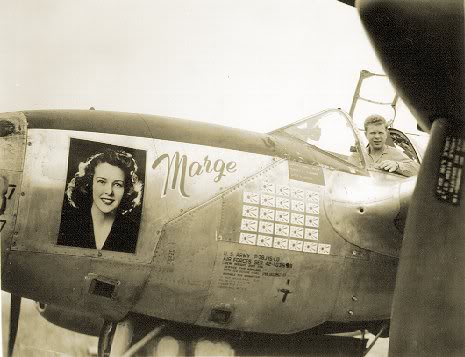 Richard Bong in his P-38 named "Marge". |
| Richard Bong was America’s all-time leading fighter ace. All of his forty victories were performed in a P-38. In San Francisco Richard Bong looped-the-loop around the Golden Gate Bridge. He then buzzed Market Street in his Lightning and waved at the stenographers staring in astonishment out of office windows. Though General Kenney had given him a stiff talking to, he knew that Dick Bong had the makings of a first-rate fighter pilot. At the age of 24, Major Richard I. Bong lost his life in the fiery crash of a P-80 jet he was testing for the Air Force on 6 August 1945 (the same day the B-29 Enola Gay dropped an atomic bomb on Hiroshima.) |
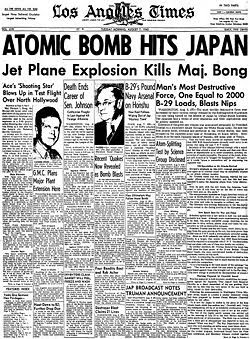
|
|
| |
|
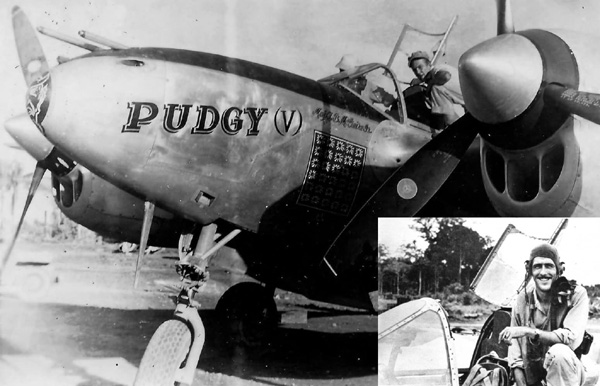 Tom McGuire scored 38 aerial victories in a P-38, making him our nation's second highest scoring ace. He was awarded the Medal of Honor for shooting down seven enemy aircraft on 25/26 December 1944. He crashed to his death 7 January 1945, on Los Negros Island, Philippines, while performing a risky maneuver to save the life of a comrade. |
| Specifications: | ||
|---|---|---|
| Lockheed P-38 Lightning | ||
| Dimensions: | ||
| P-38J | P-38L | |
| Number Built: | 2,970 | 3,810 |
| Wing span: | 52 ft 0 in (15.84 m) | 52 ft 0 in (15.84 m) |
| Length: | 37 ft 10 in (11.53 m) | 37 ft 10 in (11.53 m) |
| Height: | 12 ft 10 in (3.91 m) | 12 ft 10 in (3.91 m) |
| Weights: | ||
| Empty: | 12,780 lb. (5,797 kg) | 12,800 lb. (5,806 kg) |
| Gross: | 17,500 lb. (7,938 kg) | 17,500 lb. (7,938 kg) |
| Performance: | ||
| Maximum Speed: | 414 mph (666 km/h) at 25,000 ft. (7,620 m) |
414 mph (666 km/h) at 25,000 ft. (7,620 m) |
| Service Ceiling: | 44,000 ft. (13,410 m) | 44,000 ft. (13,410 m) |
| Range: | 450 miles (725 km) | 450 miles (725 km) |
| Max Range: | 2,600 miles (4,185 km) | 2,600 miles (4,185 km) |
| Powerplant: |
Two 1,425 hp (1,062 kW) Allison V-1710-89/91 |
Two 1,425 hp (1,062 kW) Allison V-1710-111/113 |
| Armament: |
1 x 20 mm cannon,
4 x 0.50 caliber 3,200 lbs (1,450 kg) bombs. |
1 x 20 mm cannon,
4 x 0.50 caliber 2,000 lbs (907 kg) bombs, or ten 5 in. rockets, |
Endnotes:
|
1. Larry Davis, Don Greer, Perry Manley and Joe Sewell. P-38 Lightning in action. Carton, Texas: Squadron/Signal Publications Inc., 1990. 5. 2. Le Roy Weber. Aircraft in Profile: 106, The Lockheed P-38J-M Lightning. Garden City, New York: Doubleday & Company, Inc., 1969. 5. 3. Airspeed calculated using the NASA Mach Calculator. 4. Martin Caidin. Fork-Tailed Devil, The P-38. New York: Ballantine Books, 1976. 102. 5. The Pratt & Whitney Aircraft Story. Pratt & Whitney: 1950. 101 6. Rene J. Francillon. Japanese Aircraft of the Pacific War. Annapolis, Maryland: Naval Institute Press, 1995. 382. 7. Carroll V. Glines. Attack On Yamamoto. New York: Orion Books, 1990. 57-76. 8. Rene J. Francillon. Lockheed Aircraft since 1913. Annapolis, Maryland: Naval Institute Press, 1987. 171. |
© Larry Dwyer. The Aviation History Online Museum.
All rights reserved.
Created September 17, 1997. Updated August 31, 2024.